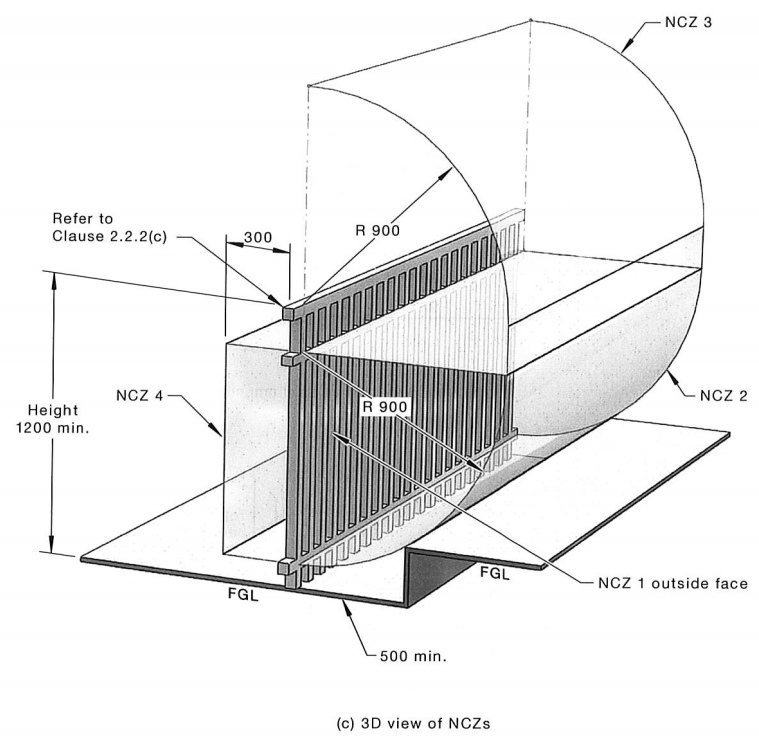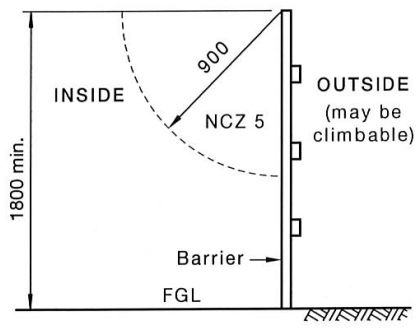Information
-
Location
-
Conducted on
-
Prepared by
-
Others present:
CPR signage:
-
Is there a warning notice (CPR Chart) erected?<br>Act s17
-
Is the sign in a prominent position in the immediate vicinity of the swimming pool?<br>Act s17(1)
-
Is the sign in a clearly legible condition?<br>Reg 98 Cl 9(c)
-
Does the signage contain:
-
The words:<br>"YOUNG CHILDREN SHOULD BE SUPERVISED WHEN USING THIS SWIMMING POOL"<br><br>Reg. 98 cl9(b)
-
Details of resuscitation techniques for infants, children and adults?<br>Reg. 98 cl9(b)
Barrier - General
-
Is the barrier a permanent structure?<br>As1926.1 2.1
Pool Barrier Fencing - Measurements
-
Is finished ground level a permanent stable surface?<br>As1926.1-2012 s1.3.6
-
Is the effective perpendicular height of the fence at least 1.2m (on the outside)?<br>As1926-1986 2.3
-
Does the fence use perforated materials or mesh (such as chain wire)?
-
Are the openings no greater than 50mm?
-
Are the openings greater than 12mm (but less than 50mm)?
-
Does the fence consist of a vertical section having an effective height of at least 1.8m, topped with an angled section measuring 450mm which is inclined to the outside of the fence at an angle of 135 degrees from the vertical?
-
Is the width of all vertical gaps <100mm?<br>As1926.1-2012 s2.3.6
-
Is the gap between bottom of barrier and finished ground level no greater than 100mm?<br>As1926.1-2012 s2.3.7
Pool Barrier Fencing <1800mm - NCZs
-
3D NCZ DIAGRAM
-
NCZ1 clear?<br>NCZ1 is measured vertically on outside face of barrier.<br>No handholds or footholds, or objects or plants that will facilitate climbing in NCZ.<br>No projections or indentations with horizontal surface >10mm.<br>As1926.1-2012 s2.2.2(a)
-
NCZ2 clear?<br>NCZ2 is a quadrant measured the outside of the barrier created by 900mm radius down from the top of NCZ1.<br>No handholds or footholds, or objects or plants that will facilitate climbing in NCZ.<br><br>Note: NCZ2 is always immediately adjacent to NCZ1 on all barriers<br>As1926.1-2012 s2.2.2(b)
-
NCZ3 clear?<br>NCZ3 is a quadrant on the outside of barrier created by a 900mm radius UP from the top of the barrier<br>No handholds or footholds, or objects or plants that will facilitate climbing<br><br>Note: If the top of NCZ1 is below the top of the barrier, NCZ3 extends vertically down to the top of NCZ1.<br>Note: NCZ3 does not apply to any item or component on, or that is part of, the barrier. NCZ3 is applicable only to the space created by the quadrant.<br>As1926.1-2012 s2.2.2(c)
-
NCZ4 clear?<br>NCZ4 is a 900mm high by 300mm deep rectangular space on the inside of the barrier, aligning with NCZ1.<br>No handholds or footholds, or objects or plants that will facilitate climbing in the NCZ.<br><br>Note: Only applies where barrier has vertical openings 10mm - 100mm in width.<br><br>As1926.1-2012 s2.2.2(d)
Boundary Pool Barrier
-
NCZ5 diagram
-
No less than 1800mm, measured from inside the pool area?<br>As1926.1-2012 s2.2.4
-
NCZ5 clear?<br>NCZ5 is a quadrant of 900mm radius, measured down from the top of the inside of the boundary pool barrier<br>No handholds or footholds, or objects or plants that will facilitate climbing in NCZ.<br>As1926.1-2012 s2.2.4(a)
-
Where internal pool barrier intersects into NCZ5, the top of internal barrier must: <br><br>- be less than 50mm and intersect at angle between 45 and 13 degrees,<br><br>OR<br><br>- continue at >1800mm for at least 900mm.<br>As1926.1-2012 s2.2.4(b)
Gates
-
Is the gate kept securely closed?<br>Act s16
-
Does gate swing away from pool area?<br>As1926.1-2012 s2.4.1.1
-
Does gate swing freely through its entire arc of operation? (i.e. cannot be wedged open)<br>As1926.1-2012 s2.4.1.1
-
Full arc of operation clear of any building or doorway?<br>As1926.1-2012 s2.4.1.1
-
Confirm overall height >1200mm (on outside of pool area)?<br>As1926.1-2012 s2.1
-
NCZs clear?
-
NCZ1?<br>As1926.1-2012 2.2.2(a)
-
NCZ2?<br>As1926.1-2012 s2.2.2(b)
-
NCZ3?<br>As1926.1-2012 s2.2.2(c)
-
NCZ4?<br>As1926.1-2012 s2.2.2(d)
-
Maximum 100mm under closed gate?<br>AS1926.1-2012 s2.4.1.1
-
Vertical spaces no more than 100mm?<br>AS1926.1-2012 s2.3.6
-
Self-closing device closes he gate from any position, with a stationary start, without the application of a manual force and operates the latch?<br> latch<br>2. From approximately half-open<br>3. From fully open position<br>4. Apply 25kg weight to gate whilst open for 30 seconds. Remove weight and let gate close under own propulsion.<br><br>AS1926.1-2012 s2.4.1.2
-
From gate resting on latch position?<br>AS1926.1-2012 s2.4.1.2
-
From partially open positions?<br>AS1926.1-2012 s2.4.1.2
-
From fully open position?<br>AS1926.1-2012 s2.4.1.2
-
From any position after a 25kg weight has been placed on the top rail or component, 100mm from the outer edge of the locking stile of the gate for 30 seconds and then removed?<br>AS1926.1-2012 s3.4
-
Lift gate upwards and pull downwards with a force of 250N.<br>The above movement of the gate must not:<br>1. Release the latch<br>2. unhinge the gate<br>3. increase gap under gate to >100mm<br><br>AS1926.1-2012 s2.4.1.3
-
Was a force gauge used to measure force applied?
-
Latch shall not be able to:<br>1. be inadvertently adjusted during operation<br>2. Locked in the 'open' position<br>3. adjusted without use of tools<br>AS1926.1-2012 s2.4.2.1
-
Release point for latch?<br>Either:<br>- No less than 1500mm from finished ground level,<br>(AS1926.1-2012 s2.4.2.2)<br>OR<br>- On inside and protected by 450mm shield, so no gaps >10mm present.<br>(AS1926.1-2012 s2.4.2.3)
Strength and Rigidity
-
Conduct strength and rigidity checks to vertical openings - apply 150N. 105mm diameter metal cone should not be able to pass through opening.<br>AS1926.1-2012 s3.1 & Appendix A
-
Was a forge gauge or similar measuring device used?
-
Conduct strength and rigidity checks to posts and footings - apply 330N of force at 1200mm height - no damage or loosening?<br>AS1926.1-2012 s3.2
-
Was a forge gauge or similar measuring device used?
-
Conduct strength and rigidity to rails/horizontals - apply 330N of force - no deformation or breakage?<br>AS1926.1-2012 s3.3
-
Was a forge gauge or similar measuring device used?
Overview
-
I have taken photographs of any non-compliance in the relevant sections.
-
Take photographs showing the general condition of the barrier here
-
Sketch if required
-
Additional Comments
-
Is there a significant risk to public safety?
-
Section 23A(1) of the NSW Swimming Pools Act 1992 (as in force at time of writing) allows the Council to carry out some or all of the requirements of a direction it has given if the Council considers that the requirements of the direction need to be carried out urgently as there is a significant risk to public safety.
-
What is the nature of the risk to public safety?
-
Is the safety of a person at risk?
-
If Council considers that the safety of a person is at risk if the requirements of a direction were not carried out as soon as possible, it may serve the direction without notice. See section 23(6) of the Swimming Pools Act 1992.
-
What is the nature of the risk?








